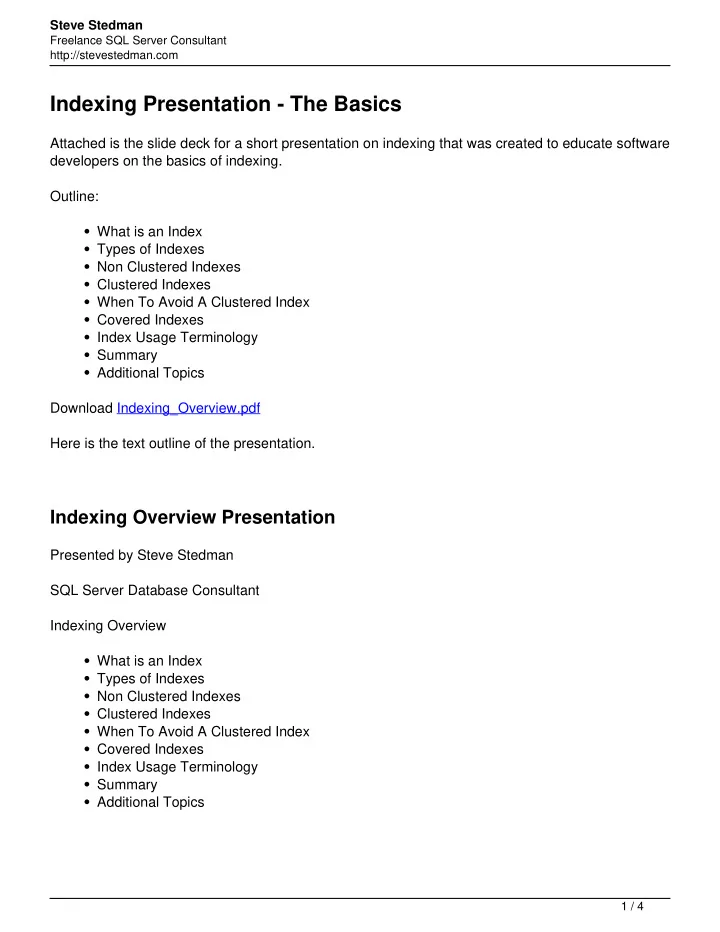

Steve Stedman Freelance SQL Server Consultant http://stevestedman.com Indexing Presentation - The Basics Attached is the slide deck for a short presentation on indexing that was created to educate software developers on the basics of indexing. Outline: What is an Index Types of Indexes Non Clustered Indexes Clustered Indexes When To Avoid A Clustered Index Covered Indexes Index Usage Terminology Summary Additional Topics Download Indexing_Overview.pdf Here is the text outline of the presentation. Indexing Overview Presentation Presented by Steve Stedman SQL Server Database Consultant Indexing Overview What is an Index Types of Indexes Non Clustered Indexes Clustered Indexes When To Avoid A Clustered Index Covered Indexes Index Usage Terminology Summary Additional Topics 1 / 4
Steve Stedman Freelance SQL Server Consultant http://stevestedman.com What is an Index Similar to the index at the back of a book. An index provides a shortcut to get to your data. Without an index to find a specific row in a table, it would required a full table scan. Types of Indexes Two types of indexes in SQL Server Non-Clustered Indexes Traditional Indexing – contains pointers to the data. Clustered Indexes Reorganizes the actual data on disk. Non Clustered Indexes Not required, but clustered indexes are recommended Contain only the data specified in the index. Do not change the base layout of the tables. Index structure is separate from the base table. Use pointers to get to the data. Can be created on most data types including char(), varchar(), and uniqueidentifiers. Only one non-clustered index can be used per table reference in a query. Can improve performance with multiple columns. Clustered Indexes Causes base table structure to change. Only one clustered index per table. Not required on a table. Should never contain char(), varchar(), varbinary(), uniqueidentifiers, or other large or widely distributed identifiers. Can significantly increase the size of a table and the database. Can increase performance if used correctly. When To Avoid A Clustered Index If you already have a clustered index on a table you can't create a second one. Never use a clustered index on a GUID / UniqueIdentifier 2 / 4
Steve Stedman Freelance SQL Server Consultant http://stevestedman.com Covered Indexes Returns query results without accessing the base table. Can lead to major performance increases. Applies to Non-Clustered Indexes. All columns requested in the query are somewhere in the index regardless of : Where they are in the query Where they are in the index Index Usage Terminology An Index Scan accesses all the rows in the index. An Index Seek uses selective rows in the index. The Seek is much quicker than the scan. Summary What is an Index Types of Indexes Non Clustered Indexes Clustered Indexes When To Avoid A Clustered Index Covered Indexes Index Usage Terminology Summary Additional Topics Additional Topics Determining Index Usage Indexing for Preformance When an Index is not used 3 / 4
Steve Stedman Freelance SQL Server Consultant http://stevestedman.com 4 / 4 Powered by TCPDF (www.tcpdf.org)
Recommend
More recommend